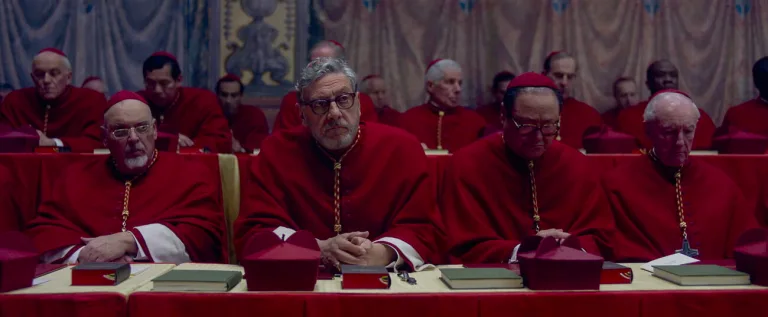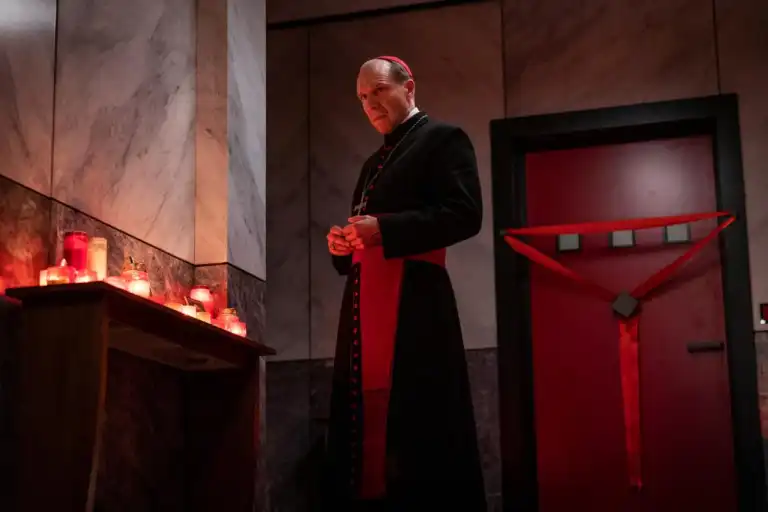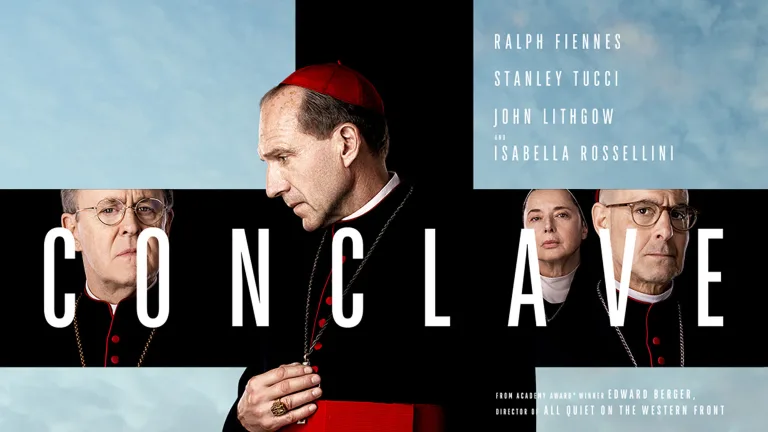One of the best films of the year and currently shortlisted for the 2025 Golden Globes, Conclave is a powerful exploration of faith, politics, and the human spirit. Directed by Edward Berger—acclaimed for All Quiet on the Western Front—this film offers a gripping portrayal of the election of a new Pope within the Roman Catholic Church, one that’s as intense and dramatic as any presidential race. Through it, the film lays bare the inextricable link between religion, politics, and society.
Note: The following contains spoilers

A Papal Election as Tense as a Political Battle
Set in the aftermath of a Pope’s death, Conclave follows the secretive process by which the Cardinals gather at the Vatican to elect a new leader of the Roman Catholic Church—a faith followed by 1.3 billion people. Given the Church’s global influence, the Pope is arguably one of the most powerful figures in the world, surpassing even the U.S. President or the UN Secretary-General. The election is conducted under strict isolation within Vatican walls to prevent external interference and ensure focus.
Each Candidate Represents a Distinct Ideology
Six Cardinals emerge as key contenders:
- Lawrance – An English Dean and the film’s protagonist. Disinterested in power, he wants to resign but is denied by the late Pope. He stays not out of ambition, but duty.
- Bellini – Despite his Italian name, he represents the American church. A progressive voice, he supports reform, interfaith respect, women’s rights, and the LGBTQ+ community. Backed by a group of liberal Cardinals, including Lawrance.
- Tedesco – An Italian Cardinal with far-right ideologies, the polar opposite of Bellini. He wants a return to traditionalism and views Islam as a threat. His aggressive, authoritarian demeanor is reminiscent of Donald Trump.
- Tremblay – From Canada, he presents a composed, experienced front but is a cunning political operator, full of schemes and strategic manipulation.
- Adeyemi – An African Cardinal portrayed as conservative and discriminatory towards women and the LGBTQ+ community. Still, he garners strong support from African Cardinals and is poised to become the first Black Pope.
- Benitez – A surprise candidate, secretly appointed by the late Pope. He represents the Catholic Church in Afghanistan, a Muslim-majority nation, and is largely dismissed by others.
The election plays out like a high-stakes game of chess, where each Cardinal is a piece on the board of religious and political maneuvering. As the drama unfolds, the ideological battles reflect real-world tensions—liberal versus conservative, tradition versus reform, and inclusion versus exclusion.
Manipulations and Power Plays
As Adeyemi leads in early voting, a scandal from his past is weaponized against him. A woman he was romantically involved with decades ago is brought to the Vatican, leading to a public outburst that tarnishes his image. Tremblay rises in the polls. Even Bellini chooses to back him to block Tedesco’s victory.
Just when Tremblay’s path to victory seems inevitable, Lawrance takes it upon himself to investigate. He uncovers evidence of Tremblay’s corruption and urges Bellini to expose it. Bellini declines, not wanting to seem like he’s sabotaging a rival—but in truth, he’s lost heart and may have been compromised.
Unable to rely on Bellini, Lawrance reveals the truth himself. Tremblay falls, and unexpectedly, the path clears for Tedesco—the one candidate both Bellini and Lawrance had hoped to avoid.

An Unexpected Twist
In the midst of this power struggle, a suicide bombing rocks the Vatican. Though no Cardinals are injured, the roof is destroyed, and the election is put on pause.
Tedesco seizes the moment, using the attack to stoke anti-Islamic sentiment and promise a hardline stance. Many right-wing Cardinals rally behind him. But then Benitez speaks. For the first time, this quiet Cardinal from Afghanistan opens up. He talks about war, humanity, and how hatred only breeds more hatred. His heartfelt words cast a long shadow over Tedesco’s aggressive rhetoric. Disillusioned, Benitez announces this will be his last Conclave.
This bombing becomes a pivotal moment. As Lawrance lies on the ground injured by falling debris, he looks up and sees a shaft of light piercing through the damaged roof—symbolizing both destruction and revelation. The explosion exposes Tedesco’s war-hawk nature but also allows Benitez’s compassion to shine. His sincerity moves the room, undercutting Tedesco’s appeal.
A Crisis of Faith and Candidates
As the election continues, it becomes clear that each leading candidate is deeply flawed—too extreme, too weak, too ambitious, or too inflexible. Lawrance, though morally upright and guided by duty, never sought power. Only when he sees that the Church’s future is at stake does he begin to consider stepping forward. Supported wholeheartedly by Benitez, he reluctantly emerges as a candidate.
A Heavy Atmosphere of Mourning and Suspense
The film maintains a somber and tense mood throughout—mourning the death of the Pope, yet thick with political calculation. The Vatican feels like a sealed institution, closed off from the world, until the bombing creates an opening for light and fresh air. In that metaphorical breath of air, the Church begins to change. In the end, the leading contenders fall due to their own ambition. The one who never wanted power proves most worthy—because his actions come from the heart.
A Deeply Human Message
Beyond its commentary on politics and society, Conclave delivers a powerful moral message. The newly elected Pope turns out to be intersex—something that, if it happened in real life, would shock the world and stir backlash from conservatives. But the film affirms its message through this brave choice. The new Pope says he cherishes who he is because God made him that way.
Through this groundbreaking plot twist, the film makes a bold yet heartfelt statement in support of LGBTQ+ rights, equality in religious and political life, and self-acceptance—while remaining in harmony with a core Catholic teaching: to respect yourself as God created you.
Though it exposes the Church’s darker sides—its political nature, ambition, corruption, misogyny, and conservatism—Conclave still holds out hope. It acknowledges the Church’s past failings but suggests it can change, just as the explosion brings light into the heart of the Vatican. One Cardinal says it best: “We are merely mortals. We serve an ideal. We ourselves cannot always be ideal.” In the end, the path forward lies not in power plays, but in compassion, humility, and heart.

Characters and Performances
Lawrance is the film’s emotional and moral anchor. Without him, the secrets of the other candidates would remain hidden. Without him, the new Pope would never have emerged, and the Church might have remained in darkness. Ralph Fiennes—famous for playing Voldemort in Harry Potter—delivers a nuanced and commanding performance. It’s almost poetic: from the Dark Lord to a Cardinal guiding the Church toward the light.
Cinematic Language
The film also excels technically. The production design, cinematography, editing, and score work in harmony to create a reverent, tense, and suffocating atmosphere befitting the religious and political stakes.
Final Thoughts
Conclave is undoubtedly one of the finest films of 2024. While it’s likely to face criticism—especially from devout Catholics—for its unflinching political lens on a sacred process, its message remains undeniable. The story is gripping, gradually exposing the hidden flaws and ambitions of each candidate. The Conclave becomes a battleground of ideologies, and yet, the film reminds us that only one force can truly guide us: the heart. Genuine compassion, unselfish care, and faith in who we are—because if God exists, surely He wants us to love ourselves and those around us. That is the film’s ultimate message.






